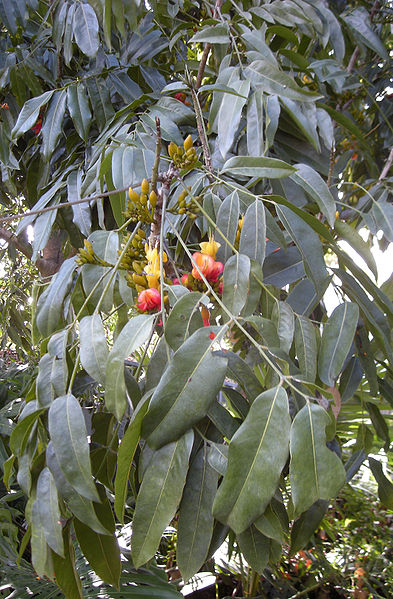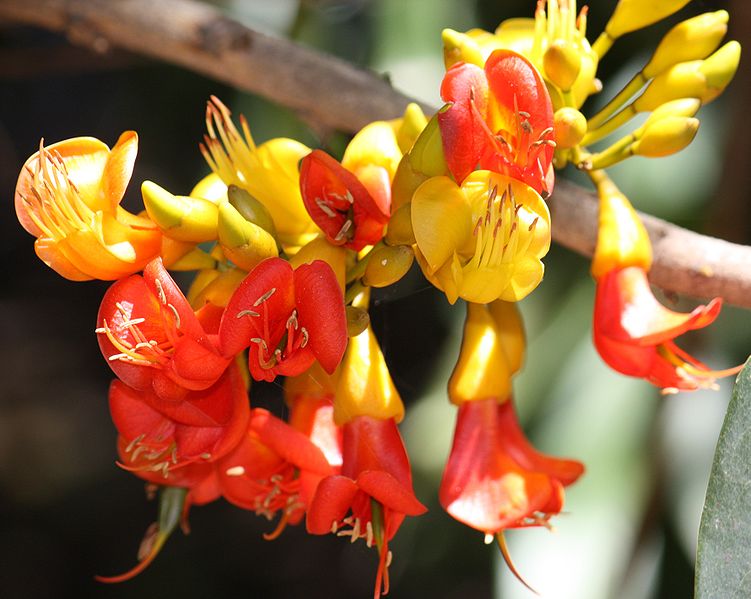 |
|
http://commons.wikimedia.org/wiki/File:Castanospermum_australe_flowers_and_foliage.jpg |
 |
| http://www.flickr.com/people/26085795@N02 |
Translate this page:
Summary
Other common names include Morten Bay Chestnut, Morton Bay Chestnut, Black Bean Chestnut.
Moreto Bay Chestnut or Castanospermum austral is a tropical, evergreen tree of about 18-35 m tall and 5-12 m width with an erect trunk, grey to brown smooth bark, and glossy dark green leaves. The flowers are pea-shaped, yellow to orange in colour and form into clusters. The seed is edible when cooked but requires extensive leeching prior to consumption due to its high saponins content. Further, it contains castanospermine, a compound which may be useful as HIV inhibitors. C.australe has an extensive root system. The wood is durable, hard, and heavy and is used as material for construction, etc.
Physical Characteristics

 Castanospermum australe is an evergreen Tree growing to 25 m (82ft) by 20 m (65ft) at a slow rate.
Castanospermum australe is an evergreen Tree growing to 25 m (82ft) by 20 m (65ft) at a slow rate.
See above for USDA hardiness. It is hardy to UK zone 9. It is in leaf all year, in flower from September to October. The species is hermaphrodite (has both male and female organs) and is pollinated by Birds.
It can fix Nitrogen.
It is noted for attracting wildlife.
Suitable for: light (sandy), medium (loamy) and heavy (clay) soils and prefers well-drained soil. Suitable pH: mildly acid and neutral soils and can grow in very acid soils.
It cannot grow in the shade. It prefers moist soil.
UK Hardiness Map
US Hardiness Map
Synonyms
Plant Habitats
Woodland Garden Canopy; South Wall. By. West Wall. By.
Edible Uses
Edible Parts: Seed
Edible Uses:
Seed - cooked[ 1 , 46 , 61 , 105 ]. The fresh raw seed contains high levels of saponins[ 238 ] and can be harmful[ 34 , 63 ]. The cooked seed tastes like a sweet chestnut[ 2 ]. It probably requires considerable leeching before it is safe to eat[ 144 ]. The Australian aborigines finely sliced the seeds and soaked them in running water for 10 days before roasting them and grinding them into a powder[ 193 ]. This powder could be stored for later use[ 193 ]. The seeds are about 3 - 4.5cm wide and are carried in pods 10 - 25cm long and containing 3 - 5 seeds[ 193 , 260 ].
References More on Edible Uses
Medicinal Uses
Plants For A Future can not take any responsibility for any adverse effects from the use of plants. Always seek advice from a professional before using a plant medicinally.
Astringent Miscellany
The seed yields compounds called castanospermine that are under investigation as HIV inhibitors and might be useful in the treatment of AIDS[ 200 , 238 , 260 , 303 ]. The seedpods are astringent[ 240 ]. Used to treat post-prandial hyperglycaemia in diabetic patients[ 303 ].
References More on Medicinal Uses
The Bookshop: Edible Plant Books
Our Latest books on Perennial Plants For Food Forests and Permaculture Gardens in paperback or digital formats.

Edible Tropical Plants
Food Forest Plants for Hotter Conditions: 250+ Plants For Tropical Food Forests & Permaculture Gardens.
More

Edible Temperate Plants
Plants for Your Food Forest: 500 Plants for Temperate Food Forests & Permaculture Gardens.
More

More Books
PFAF have eight books available in paperback and digital formats. Browse the shop for more information.
Shop Now
Other Uses
Miscellany Wood
Other uses rating: Medium (3/5). Flowering tree, Public open spaces, Street tree, Specimen. Agroforestry Uses: The extensive root system is used to protect riverbanks and catchment areas in Australia[ 303 ]. Other Uses The seeds have a high saponin content[ 238 ]. Although the report does not elaborate, the saponins could probably be used as a soap substitute[ K ]. The seeds contain toxic saponins which are reportedly toxic to a serious pest of stored grain[ 303 ]. The wood can be used as a fuel[ 303 ]. Wood - durable, resists decay, hard, heavy, polishes well, has a high resistance to the passage of electric current. The sapwood varies from white to yellow. The heartwood is dark-brown to almost black, slightly greasy and straight grained but sometimes interlocked[ 303 ]. Used in construction, cabinet making, carving etc[ 61 , 144 , 156 , 167 ]. One of the most valuable woods in Australia, the sliced veneers can be good substitute for teak[ 303 ]. The wood has a density of 700 kg /cu m[ 303 ].
Special Uses
Carbon Farming Nitrogen Fixer Scented Plants
References More on Other Uses
Cultivation details
Industrial Crop: Starch Management: Standard Regional Crop
A tree of moist, lowland tropical and subtropical climates, it grows best at an elevation between 50 - 750 metres[ 303 , 418 ]. It grows best in areas where annual daytime temperatures are within the range 20 - 32°c, but can tolerate 10 - 41°c[ 418 ]. It prefers a mean annual rainfall in the range 1,600 - 3,200mm, but tolerates 1,000 - 3,800mm[ 418 ]. Requires a very well-drained[ 260 ] but moist high-grade soil and a very sunny position when grown in areas cooler than its natural climate[ 167 , 200 ]. Prefers a pH in the range 5 - 6, tolerating 4.5 - 6.5[ 418 ]. The crushed leaves smell like cucumbers[ 193 ]. Flowers are produced on the old wood[ 260 ]. The flowers are rich in nectar and are pollinated by parrots in the wild[ 260 ]. This species has a symbiotic relationship with certain soil bacteria, these bacteria form nodules on the roots and fix atmospheric nitrogen. Some of this nitrogen is utilized by the growing plant but some can also be used by other plants growing nearby[ 200 ].
Carbon Farming
-
Industrial Crop: Starch
Materials and chemicals include bioplastics, paper, cardboard, solvents, paints, glues etc. Plants are usually pods, starchy fruits, nuts & seeds, starchy trunks.
-
Management: Standard
Plants grow to their standard height. Harvest fruit, seeds, or other products. Non-Destructive management systems.
-
Regional Crop
These crops have been domesticated and cultivated regionally but have not been adopted elsewhere and are typically not traded globally, Examples in this broad category include perennial cottons and many nuts and staple fruits.
References Carbon Farming Information and Carbon Sequestration Information
Temperature Converter
Type a value in the Celsius field to convert the value to Fahrenheit:
Fahrenheit:
The PFAF Bookshop
Plants For A Future have a number of books available in paperback and digital form. Book titles include Edible Plants, Edible Perennials, Edible Trees,Edible Shrubs, Woodland Gardening, and Temperate Food Forest Plants. Our new book is Food Forest Plants For Hotter Conditions (Tropical and Sub-Tropical).
Shop Now
Plant Propagation
Seed. Prick out the seedlings into individual deep pots as soon as they are large enough to handle and plant out when 15cm or more tall.
Other Names
If available other names are mentioned here
Other Names: Australian chestnut, Bean tree, Black bean.
Native Plant Search
Search over 900 plants ideal for food forests and permaculture gardens. Filter to search native plants to your area. The plants selected are the plants in our book 'Plants For Your Food Forest: 500 Plants for Temperate Food Forests and Permaculture Gardens, as well as plants chosen for our forthcoming related books for Tropical/Hot Wet Climates and Mediterranean/Hot Dry Climates. Native Plant Search
Found In
Countries where the plant has been found are listed here if the information is available
Found In: Africa, Asia, Australia, Central America, East Africa, Fiji, Hawaii, India, Kenya, New Caledonia, Malaysia, Mozambique, Norfolk Island, Pacific, Pakistan, Papua New Guinea, PNG, SE Asia, Solomon Islands, Southern Africa, Sri Lanka, USA, Vanuatu, West Indies, Zimbabwe.
Weed Potential
Right plant wrong place. We are currently updating this section.
Please note that a plant may be invasive in one area but may not in your area so it’s worth checking.
None Known
Conservation Status
IUCN Red List of Threatened Plants Status : This taxon has not yet been assessed.

Growth: S = slow M = medium F = fast. Soil: L = light (sandy) M = medium H = heavy (clay). pH: A = acid N = neutral B = basic (alkaline). Shade: F = full shade S = semi-shade N = no shade. Moisture: D = dry M = Moist We = wet Wa = water.

Expert comment
Author
A.Cunn.&C.Fraser. ex Hook.
Botanical References
200
Links / References
For a list of references used on this page please go here
Readers comment